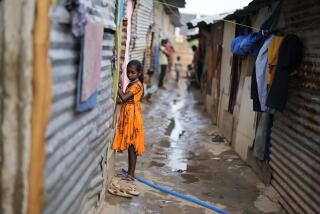Children Get a Respite From War
- Share via
NEW DELHI — In the Kashmiri border village where his father was killed, 9-year-old Mohammad Maqbool lives a reality alien to most children: gun battles, earthshaking artillery fire and the endless fear of death.
Now he has seen a different side of life: the broad avenues of New Delhi, bright lights, trains, amusement parks, ancient palaces -- and the Taj Mahal.
Most children in Kashmir’s far-flung villages never travel out of their own areas, growing up isolated amid the violence of their Himalayan homeland.
An Indian army program is trying to change that, taking children on free trips to Indian cities as a way to win the hearts of the Kashmiri people. Hundreds of children have taken part in the program over the last five years, going on trips that last from a few days to two weeks.
Maqbool’s group came from the border district of Kupwara, which sits along the disputed frontier that divides Kashmir between India and Pakistan. Shelling and rebel attacks have been the norm since Islamic militants revolted 13 years ago.
Jammu-Kashmir is the only predominantly Muslim state in India, where Hindus are the majority. Many Kashmiri Muslims in the northern state distrust and disdain the Indian government and the security forces that guard the valley.
Indian officials want to present a kinder face to the children, who have seen so much blood.
“The aim was to enhance the vision of Kashmiri boys and girls because the children are surviving under the shadow of the gun,” said Brig. Shruti Kant, an Indian army spokesman. “When the first group came, 90% had never seen a car, no one had seen a train, and half had never traveled in a bus. They had no idea what the outside world looked like.”
But most Kashmiri children have experienced the trauma of war.
Maqbool’s father, a soldier, was killed eight years ago by Islamic guerrillas. “I want to get into the army like my father,” he said during his New Delhi tour.
Most children in the program are too young to have memories of a peaceful Kashmir, which once drew hordes of tourists to its majestic mountains, floating gardens and beautiful Dal Lake.
“This is my first visit out of my village and I am very excited,” Maqbool said as he walked around the 17th-century Red Fortin New Delhi.
The children traveled in a bus on the capital’s wide roads, past large buildings and through the city’s notoriously unruly traffic.
“I like Delhi. It’s beautiful. I want to work here someday. Maybe I could become a doctor,” said Zahida Ahmed Shah, a girl in the 10th grade.
The 13 boys and seven girls were accompanied by an army captain and four teachers.
They visited the Mughal Gardens, a dazzling display of spring flowers at the residence of India’s president. They saw the Qutab Minar, the 12th-century, 236-foot-tall tower and the British colonial-era India Gate.
“Now we will go to ride on the Metro, and tomorrow to the Taj Mahal and then the forts in Rajasthan. I have just seen pictures of the Taj,” said Asia Taimoor Shah, 12, of Dragmulla village.
More than 61,000 people have died in the Kashmir insurgency. Most were civilians, gunned down in the cross-fire, targeted by rebels as suspected informants or who “disappeared” after being taken away by Indian security forces for interrogation.
Children witness household searches, late-night raids and the humiliating frisking of people, who are ordered off public buses with their arms in the air. Unlike elsewhere in India, every Kashmiri man must carry an identification card.
Any bitterness the children might feel seemed to melt away on the tour. At the Appu Ghar amusement park, they shrieked as they whisked down waterslides. One boy took off his shirt and twirled it in the air. “Like a movie star,” he shouted.
Their smiles faded for a few seconds at Red Fort when they heard a nearby pop-pop-pop that sounded like the gunshots familiar back home.
All heads turned, but it was just the backfire of a motorcycle.
More to Read
Sign up for Essential California
The most important California stories and recommendations in your inbox every morning.
You may occasionally receive promotional content from the Los Angeles Times.













